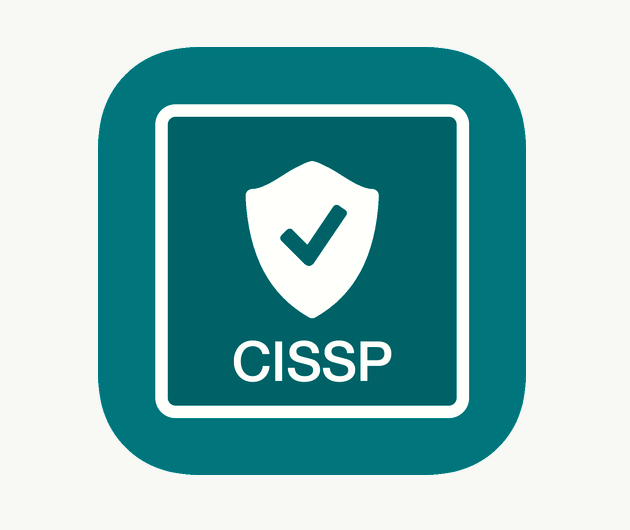CISSP - Question Bank 10
Test your knowledge of CISSP with these multiple choice questions. Each Question Bank includes 20 practice questions that have been designed to measure your knowledge of key ideas.
A key factor to keep in mind is that guessing is better than not answering a question.
Every single question on the CISSP exam is a four-option multiple choice question with a single correct answer. Some are straightforward, such as asking you to select a definition. Some are a bit more involved, such as asking you to select the appropriate concept or best practice. And some questions present you with a scenario or situation and ask you to select the best response.
StartQ1. In the RSA public key cryptosystem, which one of the following numbers will always be largest?
A. e
B. n
C. p
D. q
Q2. Which cryptographic algorithm forms the basis of the El Gamal cryptosystem?
A. RSA
B. Diffie-Hellman
C. 3DES
D. IDEA
Q3. If Richard wants to send an encrypted message to Sue using a public key cryptosystem, which key does he use to encrypt the message?
A. Richard's public key
B. Richard's private key
C. Sue's public key
D. Sue's private key
Q4. If a 2,048-bit plaintext message was encrypted with the El Gamal public key cryptosystem, how long would the resulting ciphertext message be?
A. 1,024 bits
B. 2,048 bits
C. 4,096 bits
D. 8,192 bits
Q5. Acme Widgets currently uses a 1,024-bit RSA encryption standard companywide. The company plans to convert from RSA to an elliptic curve cryptosystem. If it wishes to maintain the same cryptographic strength, what ECC key length should it use?
A. 160 bits
B. 512 bits
C. 1,024 bits
D. 2,048 bits
Q6. John would like to produce a message digest of a 2,048-byte message he plans to send to Mary. If he uses the SHA-1 hashing algorithm, what size will the message digest for this particular message be?
A. 160 bits
B. 512 bits
C. 1,024 bits
D. 2,048 bits
Q7. Which one of the following message digest algorithms is considered flawed and should no longer be used?
A. SHA-1
B. MD2
C. MD4
D. MD5
Q8. Which one of the following message digest algorithms is the current U.S. government standard in use by secure federal information processing systems?
A. SHA-1
B. MD2
C. MD4
D. MD5
Q9. Richard received an encrypted message sent to him from Sue. Which key should he use to decrypt the message?
A. Richard's public key
B. Richard's private key
C. Sue's public key
D. Sue's private key
Q10. Richard would like to digitally sign a message he’s sending to Sue so that Sue can be sure the message came from him without modification while in transit. Which key should he use to encrypt the message digest?
A. Richard's public key
B. Richard's private key
C. Sue's public key
D. Sue's private key
Q11. Which one of the following algorithms is not supported by the Digital Signature Standard?
A. Digital Signature Algorithm
B. RSA
C. El Gamal DSA
D. Elliptic Curve DSA
Q12. Which International Telecommunications Union (ITU) standard governs the creation and endorsement of digital certificates for secure electronic communication?
A. X.500
B. X.509
C. X.900
D. X.905
Q13. What cryptosystem provides the encryption/decryption technology for the commercial version of Phil Zimmerman's Pretty Good Privacy secure e-mail system?
A. DES/3DES
B. IDEA
C. ECC
D. El Gamal
Q14. What TCP/IP communications port is utilized by Secure Sockets Layer traffic?
A. 80
B. 220
C. 443
D. 559
Q15. What type of cryptographic attack rendered Double DES (2DES) no more effective than standard DES encryption?
A. Birthday
B. Chosen ciphertext
C. Meet-in-the-middle
D. Man-in-the-middle
Q16. Which of the following security systems was created to support the use of stored-value payment cards?
A. SET
B. IPSec
C. MONDEX
D. PGP
Q17. Which of the following links would be protected by WEP encryption?
A. Firewall to firewall
B. Router to firewall
C. Client to wireless access point
D. Wireless access point to router
Q18. What is the major disadvantage of using certificate revocation lists?
A. Key management
B. Latency
C. Record keeping
D. Vulnerability to brute force attacks
Explanation: Certificate revocation lists (CRLs) introduce an inherent latency to the certificate expiration process due to the time lag between CRL distributions.
Q19. Which one of the following encryption algorithms is now considered insecure?
A. El Gamal
B. RSA
C. Skipjack
D. Merkle-Hellman Knapsack
Q20. What does IPSec define?
A. All possible security classifications for a specific configuration
B. A framework for setting up a secure communication channel
C. The valid transition states in the Biba model
D. TCSEC security categories
- Question Bank 00
- Question Bank 01
- Question Bank 02
- Question Bank 03
- Question Bank 04
- Question Bank 05
- Question Bank 06
- Question Bank 07
- Question Bank 08
- Question Bank 09
- Question Bank 10
- Question Bank 11
- Question Bank 12
- Question Bank 13
- Question Bank 14
- Question Bank 15
- Question Bank 16
- Question Bank 17
- Question Bank 18
- Question Bank 19


